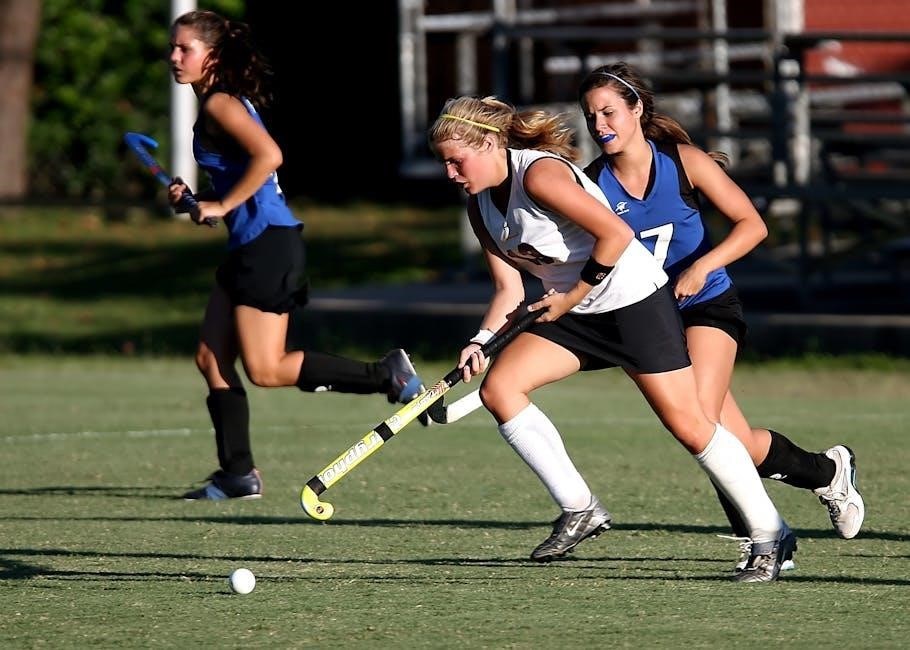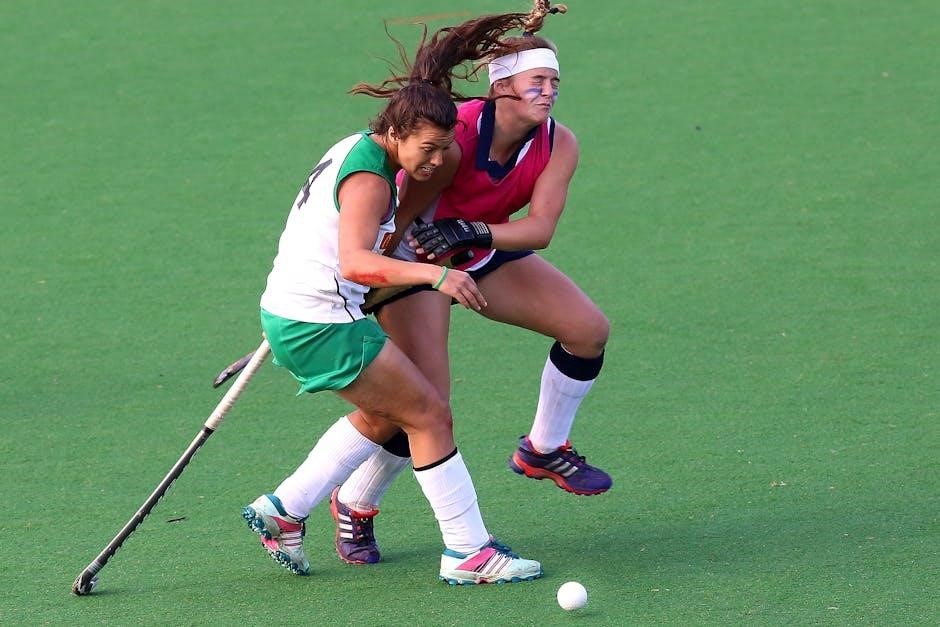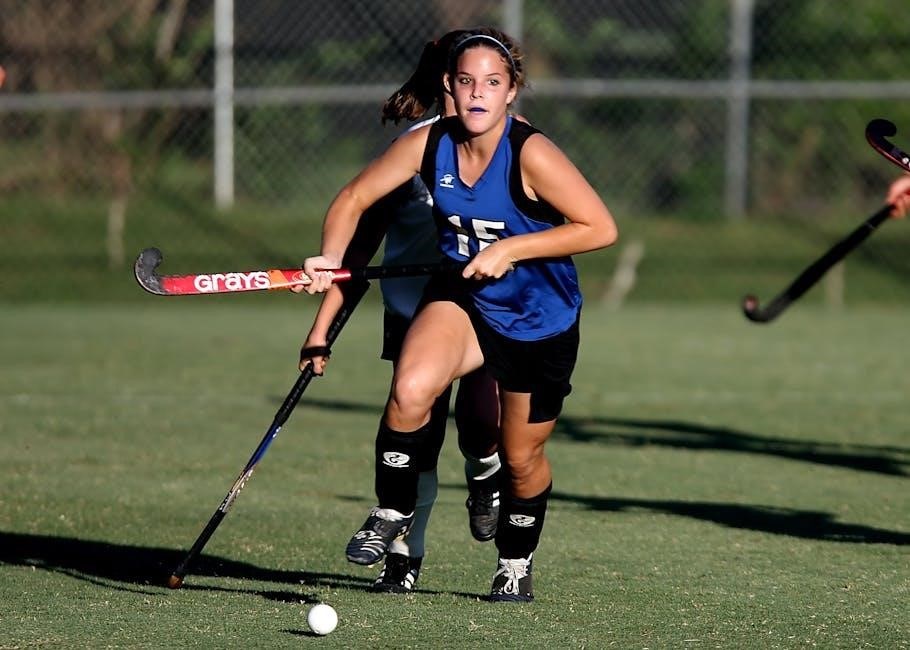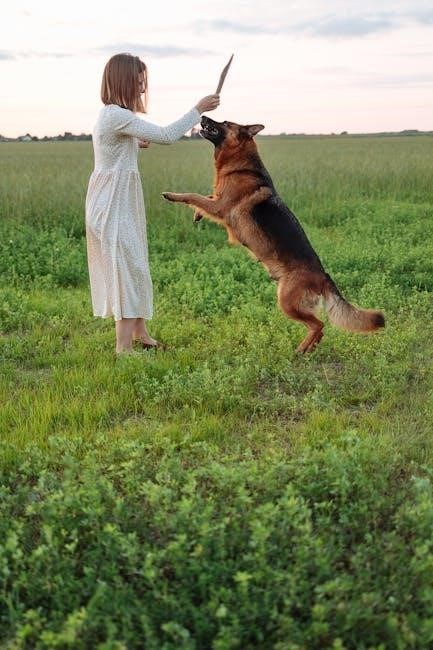Stick length is crucial for performance, safety, and adherence to rules in field hockey. This guide provides historical insights and practical advice to help players choose the right stick size.
1.1 Historical Context and Importance of Stick Length
Historically, field hockey sticks varied in length due to limited regulations. Modern standards emphasize stick length to ensure fair play and safety. The International Hockey Federation (FIH) introduced rules to standardize stick dimensions, balancing performance and player safety. Proper stick length is now crucial for optimal skill execution and adherence to rules, making it a cornerstone of the game.
1.2 Objective of the Guide
This guide aims to help players select the ideal stick length by considering height, body proportions, and playing style. It provides measurable standards and practical tips to ensure optimal performance and comfort on the field, making it a valuable resource for players of all skill levels.

Understanding Field Hockey Stick Length Requirements
Stick lengths range from 36.5 to 38.5 inches for seniors and 28 to 35 inches for juniors, aligning with player height and game regulations.
2.1 Standard Length Ranges for Players
Stick lengths vary by player height and experience. Junior sticks typically range from 28 to 35 inches, while senior sticks are longer, from 36.5 to 38.5 inches. Proper fitting ensures optimal performance and safety, with the stick reaching just below the hip bone when standing upright. This standardization helps players maintain control and technique effectively during games.
2.2 Measuring Techniques for Optimal Fit
To measure correctly, stand upright with the stick close to your body. The stick’s top should reach just below your hip bone when held vertically. This ensures proper control and technique. Measure from the floor to the hip bone for an accurate fit, allowing for optimal performance and comfort during play.
Factors Influencing Stick Length Selection
Stick length depends on player height, body proportions, and personal preference. It also varies based on the position and style of play, ensuring optimal performance.
3.1 Player Height and Body Proportions
Player height is a primary factor in determining stick length. Generally, the stick should reach from the floor to the hip bone when standing upright. For adults, sticks range from 35 to 37.5 inches, while juniors use shorter lengths. Proper alignment ensures control and comfort, making height a key measurement for optimal fit.
3.2 Personal Preference and Playing Style
Personal preference and playing style significantly influence stick length choices. Some players prefer a slightly shorter stick for better control, while others opt for longer sticks for increased reach. Forwards and midfielders often favor shorter lengths for agility, while defenders may prefer longer sticks for clearing. Skill level also plays a role, as advanced players may adjust length for specific techniques. Comfort and performance are key.

Materials and Construction Impact on Stick Length
Materials like carbon fiber, fiberglass, and wood affect stick length and performance. Carbon fiber sticks are lighter and more durable, while fiberglass adds flexibility. Construction techniques also influence length.
4.1 How Stick Materials Affect Length and Performance
Different materials significantly impact stick length and performance. Carbon fiber sticks are lighter, offering better control and power, while fiberglass adds durability and flexibility. Wooden sticks are heavier but provide a traditional feel. The choice of material affects both the stick’s length and its ability to perform in various playing conditions and positions.
4.2 Manufacturing Processes and Length Variations
Manufacturing processes significantly influence stick length variations. Advanced techniques like precision engineering ensure consistent lengths, while handcrafted sticks may vary slightly. Materials and drying processes also affect final dimensions, impacting weight, flexibility, and durability. These variations cater to different player preferences, balancing performance and personal style, ensuring optimal functionality across positions and skill levels in field hockey.

Measuring Your Ideal Stick Length
Measure from the floor to your hip bone while standing upright. Stick length should align with your height and posture for optimal comfort and performance.
5.1 Floor-to-Hip Bone Measurement
Stand upright and measure from the floor to the top of your hip bone. This method ensures the stick length aligns with your body proportions, typically ranging from 36.5 to 38.5 inches depending on height. Proper measurement guarantees optimal control and performance, avoiding sticks that are too long or short for your frame.
5.2 Standing Position and Posture Considerations
When measuring, stand upright with feet shoulder-width apart. The stick should reach just below your hip bone, ensuring proper posture and balance. A slightly bent knee and neutral spine position helps maintain control. Correct stance prevents discomfort and enhances stick handling, making it essential for accurate measurements and optimal performance on the field.

Field Hockey Stick Size Charts
Size charts provide height-to-stick-length correlations, helping players select appropriate stick sizes. These charts cater to junior and senior players, ensuring optimal fit and performance.
6.1 Junior Stick Length Recommendations
Junior sticks are designed for younger players, typically ranging from 28 to 35 inches. Height guidelines suggest sticks for players under 4’3″ are 24″, while those between 4’3″ and 4’10” use 26-28″. Taller juniors (4’10” to 5’2″) opt for 30-32″, and 5’2″ to 5’6″ use 34″. These lengths ensure proper comfort and skill development.
6.2 Senior Stick Length Recommendations
Senior sticks range from 36.5 to 38.5 inches, tailored for taller, advanced players. Heights 5’3″ to 5’9″ use 36.5″, while 5’10” to 6’2″ prefer 37.5″. Taller players (over 6’2″) opt for 38.5″. These lengths ensure optimal control and performance for experienced players, aligning with their strength and skill level for precise gameplay.

Choosing the Right Stick Based on Position
Stick length varies by position; forwards and midfielders prefer shorter sticks for agility, while defenders and goalkeepers opt for longer sticks for power and reach.
7.1 Forwards and Midfielders
Forwards and midfielders typically prefer shorter sticks, around 34-36.5 inches, for better agility and ball control. This length allows quick stickhandling and fast-paced gameplay, essential for scoring and maintaining possession. The shorter stick enables precise movements and rapid passes, making it ideal for dynamic, offensive roles. Players in these positions prioritize maneuverability over reach.
7.2 Defenders and Goalkeepers
Defenders and goalkeepers often prefer longer sticks, typically ranging from 36.5 to 38.5 inches, for enhanced reach and defensive capabilities. The added length provides better control when blocking shots and clearing the ball. Goalkeepers benefit from the extra leverage, while defenders use it to intercept passes and maintain defensive positioning effectively. Longer sticks are crucial for their roles, balancing reach and maneuverability.

Common Mistakes to Avoid
Common mistakes include ignoring height guidelines and overestimating skill level for stick length. Ensure proper fit by measuring from the floor to your hip bone for optimal performance.
8.1 Ignoring Height Guidelines
Ignoring height guidelines is a common mistake that can hinder performance and safety. Proper stick length aligns with player height, ensuring control and maneuverability. Using a stick that’s too long or short can lead to discomfort and reduced accuracy. Always measure from the floor to the hip bone to determine the ideal length, preventing poor technique and potential injuries.
8.2 Overestimating Skill Level for Stick Length
Overestimating skill level when choosing stick length is a frequent error. Advanced sticks require more strength and precision, which may not suit less experienced players. Selecting a stick that matches your current ability ensures better control and skill development, while reducing the risk of frustration and poor performance on the field hockey pitch.
This guide helps players choose the right stick length, ensuring optimal performance and safety. Always consult experts for personalized advice and proper fitting to enhance your game.
9.1 Summary of Key Points
Stick length is determined by height, reaching the hip bone. Junior sticks range from 28-35 inches, seniors from 36.5-40 inches. Proper fit enhances skill and safety. Consider personal preferences and position-specific needs. Always measure from floor to hip bone for accuracy. Consulting experts ensures optimal fit and compliance with regulations, boosting performance and enjoyment of the game.
9.2 Encouragement to Consult Experts
Consulting experts or experienced coaches is strongly recommended to ensure the best fit for your field hockey stick. They provide personalized advice based on your height, position, and playing style. Experts can also guide you through advanced factors like materials and skill level, ensuring optimal performance and safety. Their insights are invaluable for making an informed decision tailored to your needs.
